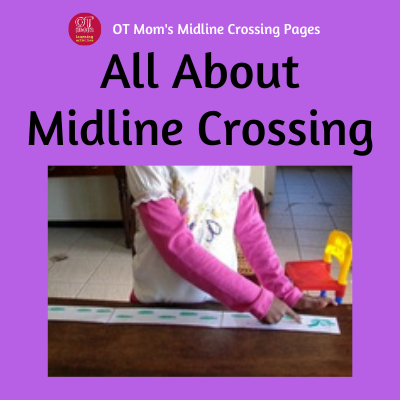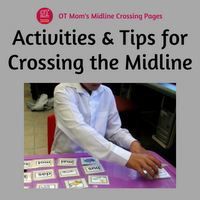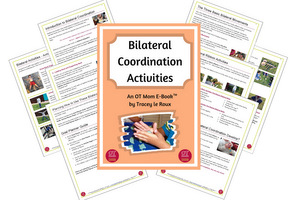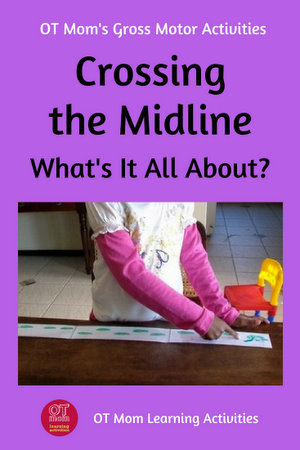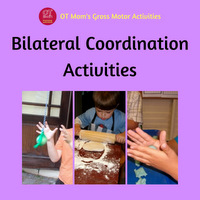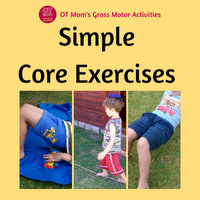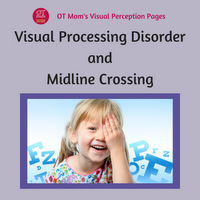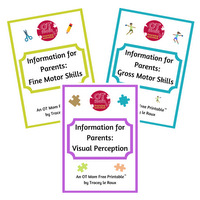- Home Page
- Crossing the Midline
Crossing The Midline
What is crossing the midline, and why is midline crossing important?
When Occupational Therapists and other health professionals talk about “midline crossing”, the midline they are referring to is an imaginary line drawn from the head to the feet that separates the left and the right halves of the body.
Crossing this midline means that a body part (eg hand or foot) is able to spontaneously move over to the other side of the body to work there. This is a normal part of your child's physical development, part of the maturation of gross motor and coordination skills.
This is a different concept to the "crossing midline" activities that are promoted in a few neurological and academic stimulation programs.
I wrote this page to help parents and teachers understand more about this physical aspect of a child's gross motor development.
I sometimes link to products (#Ad) that are similar to those I use and love. If you do purchase something through my links, I will receive a small commission that helps support my site - thank you!
How Midline Crossing Develops
Crossing of the body midline begins as early as infancy, when babies are learning to reach out for objects with both hands.
When an infant reaches with both hands to grasp a large object (eg a ball) that is positioned slightly to one side of the body, the child will end up crossing the midline to take hold of the object.
 Baby crossing the midline to grasp a toy
Baby crossing the midline to grasp a toyBilateral movements and interaction with the environment are therefore important factors in helping a child develop the skill of crossing the midline.
Young children may tend to use the left hand on the left side of the body and the right hand on the right side of the body as they play. However, as body scheme, left-right discrimination and spatial perception continue to develop between the ages of 4 – 8 years, the ability to spontaneously cross the midline also continues to develop.
There is usually a lot of maturation in this skill between the ages of 6 and 8 years old, and the skill is usually fully integrated by the ages of 8-9 years.
Factors Affecting Midline Crossing
As mentioned earlier, bilateral movements and interaction with the environment are important factors in helping a child develop the skill of crossing the midline.
When caretakers play with the child and encourage him/her to reach out, and provide objects for the child to grasp, the child has opportunities to cross midline naturally.
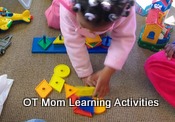 Reaching across the midline
Reaching across the midlineSpending too much time in baby gear (car seats, bouncers), having too much screen time, or growing up in a deprived situation can affect how a baby interacts with the environment, and may limit opportunities for bimanual reaching and crossing of the midline.
However, there is another vital factor in crossing the midline, and that is trunk rotation. If a child avoids rotating the trunk owing to poor core stability, and/or moves the trunk stiffly as a unit, then this may affect the child's ability to freely cross the midline.
You can see this in action in the photos below of a child throwing to a target off to her side:
The child has turned her lower body WITH the upper body, so the shoulders and the hips are moving as one unit as she throws.
There is no trunk rotation, which means she is not crossing her midline when she throws.
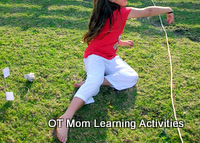 No trunk rotation thus no midline crossing
No trunk rotation thus no midline crossingThis is a better position: while sitting criss-cross, the child’s upper body has turned around (rotated), while her lower body (hips and legs) is stable and facing forward.
There is some trunk rotation and the child is crossing the midline with her throwing hand.
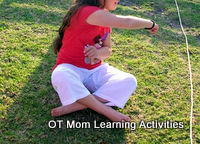 Trunk rotation enables crossing the midline
Trunk rotation enables crossing the midlineMany kids shift their body subtly to avoid rotating their trunks and therefore avoiding crossing their midline.
It usually takes a trained eye to see when they are doing this, so please do take your child for an assessment if you are all concerned about a weak core and/or poor trunk rotation and/or avoiding midline crossing.
Some parents have asked about visual processing disorder and midline crossing - you can read more details here.
Back to Top
Why Is Crossing Midline Important?
Being able to cross the midline may help a baby or toddler to interact more fully with the environment. Even if the hand on one side is occupied, the infant can cross over with the other hand to grasp a new object.
This ability can help a toddler who needs to reach for an object while creeping/crawling, as well as babies who are learning to feed themselves.
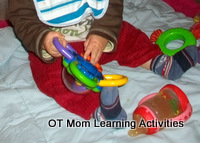 Exploring toys with both hands
Exploring toys with both handsChildren need to develop a strong preferred hand for tool use (cutting with scissors, drawing with a crayon etc) by the time they start formal schooling.
The ability to spontaneously cross the midline plays an important role in developing a strong preferred hand, by enabling the preferred hand to practice on both sides of the body as it crosses over the midline.
If a child avoids crossing the midline, and uses the left hand on the left side of the body and the right hand on the right side of the body, then both hands will tend to get equal practice at developing fine motor skills, and the child’s true handedness may be apparently delayed. This may affect future handwriting skills.
When Kids Have Trouble Crossing the Midline
Some children may struggle to easily cross the body midline. When a child shows hesitancy in reaching, stepping or looking across the midline of the body, this is known as midline crossing inhibition.
Sometimes this delay can be seen when a child hesitates or is clumsy during gross motor tasks which require the arm or leg to cross over to the other side.
Some children with delayed midline crossing skills may display some “compensatory mechanisms” in school that make writing really awkward for them. Have a look at the kids pictured below:
This girl has turned the paper sideways so she can write from bottom to top, instead of reaching over to her left side with her right hand to write from left to right.
 Turning paper sideways
Turning paper sidewaysThis boy has shifted his body all the way over to the left, so his right hand does not have to reach over to work on his left side.
 Shifting body to the side
Shifting body to the sideThese girls below have shifted their work over to the side to avoid crossing their midline while they work.
 Shifting work to the side
Shifting work to the side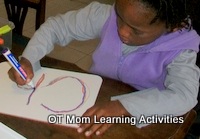 Avoiding her midline
Avoiding her midlineKids who avoid crossing their midline just seem to take up more desk space as they shift their bodies, their chairs and their work to keep their writing hand on the same side of the body!
How to Help Your Child Cross the Midline
There are so many easy ways that you can help your child developing midline crossing skills.
- I love these l-o-o-n-g visual motor worksheets that can help your child cross the midline while tracing the line.
- Or try some easy crossing the midline activities at home or in the classroom.
- Bilateral coordination skills play a vital role in many fine motor and gross motor activities, and as described above, have a role to play in midline crossing.
- If you want to support your child's development of this vital skill, then try my download full of Bilateral Coordination Activities! There are many activities in this e-book that promote midline crossing skills as well!
Thank you for visiting my site!
I hope you found this page helpful and that you now understand more about this important aspect of your child's development.
Please sign up for my free, occasional newsletter to stay in touch with updates and new releases as they happen!
- Home Page
- Crossing the Midline
Share this page to help others!
References
Cermak, S. and Ayres, J.A. (1984). Crossing the Body Midline in Learning-Disabled and Normal Children. The American Journal of Occupational Therapy. 38. 35-9. https://dx.doi.org/10.5014/ajot.38.1.35
Cermak, S.; Quintero, E.J. and Cohen, P.M. (1980). Developmental Age Trends in Crossing the Body Midline in Normal Children. The American Journal of Occupational Therapy. 34. 313-9. https://dx.doi.org/10.5014/ajot.34.5.313
Lombardi, J.A.; Surburg, P.; Eklund, S. and Koceja, D. (2000). Age Differences and Changes in Midline-Crossing Inhibition in the Lower Extremities. The Journals of Gerontology. Series A, Biological sciences and medical sciences. 55. M293-8. https://dx.doi.org/10.1093/gerona/55.5.M293
Provine, R. and Westerman, J.A. (1979). Crossing the Midline: Limits of Early Eye-Hand Behavior. Child Development. 50. 437-41. https://doi.org/10.1111/j.1467-8624.1979.tb04126.x
Smits-Engelsman, B.; Swinnen, S. and Duysens, Jacques. (2004). Are Graphomotor Tasks Affected By Working in the Contralateral Hemispace in 6- to 10-year-old Children?. Motor control. 8. 521-33. https://dx.doi.org/10.1123/mcj.8.4.521
van Hof, R.; van der Kamp, J. and Savelsbergh, G. (2002). The Relation of Unimanual and Bimanual Reaching to Crossing the Midline. Child Development. 73. 1353-62. https://dx.doi.org/10.1111/1467-8624.00476
Didn't find what you were looking for? Try a search of my site!
